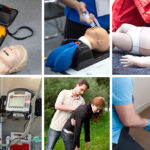One person dies every 34 seconds due to heart disease in the United States. Delays in providing emergency medical care can result in a lack of oxygen. This can, in turn, lead to permanent brain damage or death.
Fortunately, knowledge of basic life skills can reduce the death rate. BLS training equips you with the skills to take quick action. Your timely assistance can save lives.
That is why BLS training should be made mandatory at the school level. It teaches young children to recognize several life-threatening emergencies. It prepares them to respond appropriately in critical situations. Students learn to give high-quality chest compressions. They also learn to deliver appropriate ventilations. BLS training also helps them learn how to treat foreign-body airway obstruction. Even basic knowledge like calling 911 for emergency help and putting a patient in a recovery position is taught as part of the curriculum.
Knowledge of CPR and AED can be the best skill to have as a child. According to the American Heart Association, a 9-year-old can also learn these skills. In fact, several studies support children learning basic life-support skills.
But the question is: how do we bring BLS training to schools?
You can reach out to the American CPR Care Association. We have BLS training programs specifically for children. It teaches them a wide range of medical responses. This also includes how to safely and effectively perform CPR.
Overview of BLS and its importance for teachers and students
BLS training is crucial for both teachers and students. It is a set of medical skills used to provide emergency medical care. It includes medical responses such as chest compressions, rescue breathing, and using a defibrillator.
For teachers, BLS training gives them an opportunity to learn and practise life-saving skills. It teaches them to quickly respond to an emergency situation. Since teachers work with students, it is an important skill for them to have. It prepares them to give immediate attention to medical conditions or illnesses at school. It prepares them to provide the best possible care and support to their students.
For students, BLS training teaches them the importance of emergency preparedness. It imparts the necessary knowledge and skills to help them save a life. It makes them more capable of recognizing and responding to emergencies. It also develops a sense of responsibility in students.
Teachers and students both must undergo BLS training.
Why must young students have basic life support training sessions?
School children typically engage in high-risk behaviours. They perform challenging tasks and participate in extreme sports. In such environments, the need for basic life support can arise at any time. Being equipped with these skills can help children respond quickly when the need arises. It can provide the support needed until professional help arrives. It can, in turn, prevent life-threatening situations.
Imparting life-saving skills like BLS training increases young students’ preparedness for emergencies. It increases their confidence and willingness to perform BLS. It instills positive beliefs in their capabilities and promotes self-efficacy. Moreover, training at a young age helps in the long-term retention of practical BLS skills.
BLS training increases the rate of CPR performed by bystanders. This in turn increases the survival chances of a person suffering from a cardiac arrest.
In fact, the AHA recommends teaching basic life support skills in the official school curriculum. Many schools have already implemented BLS education in the last decade.
Steps to implement basic life support training in schools
The process of implementing BLS training in schools is simple. Just follow the below steps:
- Scout the internet and look for a reputed BLS training provider.
- Register and enroll in the certification course.
- Complete the course by going through our course materials.
- Take and pass the final exam.
- Receive your BLS certification.
Conclusion
Since children are quick learners and easily motivated, they must be taught BLS skills. Including the same in their school curriculum would have a greater impact on public health. Skills learnt at a young age are retained for a lifetime. Hence, this is the best age to introduce BLS knowledge and skills.
Moreover, basic life skills training will help them understand the importance of safety. The knowledge will empower them with the confidence to react calmly in emergencies.
BLS training by the American CPR Care Association is easy to understand. It is effective to prepare learners for lifesaving actions. Our training sessions are practical and instructor-led. Trained doctors and medical experts design our BLS certification courses. Children can learn from our vast online resources. These include course materials, interactive websites, worksheets and videos.
Reach out to us today to learn more about our Basic Life Support class!
Turn children into responsible citizens with American CPR Care Association!







